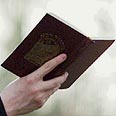
New guide for the halachic and egalitarian minyan
Egalitarian minyans are rampant throughout the country. Now thanks to PHD candidates Michal and Elitzur Bar-Asher they have a halachic guide to follow
For three years Michal and Elitzur Bar-Asher, an Israeli couple living abroad, have studied the halacha’s approach to including women in public prayer services, and have recently published a detailed guide on this rather tricky subject.
The couple’s newly published guide, the Guide for the Halachic Minyan, not only highlights the halacha’s perspective on female participation in prayer services, it also offers a detailed account of specific prayers that women may, or may not lead.
More conservative worshippers may be disappointed to discover that a woman may lead the Hallel prayer, though feminists may scoff at the fact that women are allowed to blow the shofar only on Yom Ha’atzmaut. Those following Ashkenazic decisors may even allow a woman to lead the Kol Nidrei.
Conceiving the guide
Elitzur Avraham Bar-Asher is a PhD candidate in Semitic Philology at Harvard University and lecturer in Semitics at Yale University’s Department of Near Eastern Languages and Civilizations.
His wife, Michal Bar-Asher Siegal is in the PhD program in the Judaic Studies program, Ancient Judaism at Yale University, a member of the Talmud department at Hebrew University in Jerusalem, and a visiting lecturer in the department of Religion at Smith College.
The Orthodox couple also serves as halachic consultants to congregations in Boston and New Haven, and was approached about formulating a guide for congregations looking to establish egalitarian minyans at the last Jewish Orthodox Feminist Alliance (JOFA) conference.
“According to Maimonides, both men and women are obligated in the Mitzvah of prayer. This guide’s goal is to indicate the parts of the prayer service that women may halachically lead. The guide is an outgrowth of deliberations conducted in the various prayer groups that have made it their aim to increase women’s participation in services, and it is the result of detailed study of the sources relating to holiday and Shabbat prayers,” states the introduction to the guide.
With that the guide also notes that it "does not attempt to create a unified practice among different congregations. It means only to present to interested readers the conclusions reached by those who have founded and designed the various congregations. The guide outlines the practices that we have deemed permissible; each congregation should come to its own conclusions according to its reasoning and circumstances.”
Female Gabbai can recite ‘Mi Sheberach’
Among other determinations, the guide’s compilers have noted that women may read from the Torah and receive aliyot on all days on which the Torah is read, including Shabbat. They may not receive the first two aliyot, however.
Furthermore, the guide determines that women may lead the Pesukei D’Zimra, and take part in Kabbalat Shabbat. They can also light the candles on Hannukah and fulfill the congregation’s obligation. A woman may blow the Shofar on Yom Ha’atzmaut, at the end of Yom Kippur, as well as during the Selichot recited in Elul. According to Ashkenazi tradition, women can even lead the Kol Nidrei prayers on Yom Kippur.
“We are engaged in a continuous process of study and clarification. Therefore, this guide should not be taken as comprehensive, and no inference should be made from silence,” state the Bar-Ashers.
The couple also notes that “if we do not explicitly indicate that women may lead a certain part of the prayer service, this does not mean that we have concluded that they may not. Such silences should be seen as invitations to further study of the sources that may eventually lead to the discovery of new grounds for permission.”
For the complete guide go to http://upload.kipa.co.il/media-upload/kulech/1214602.PDF










